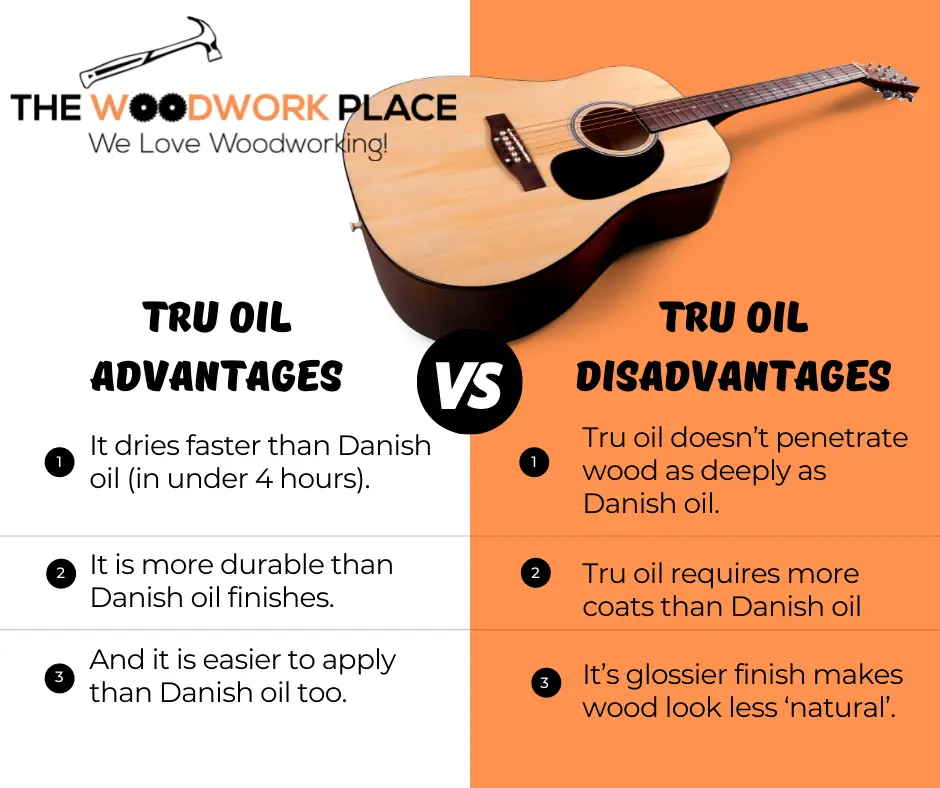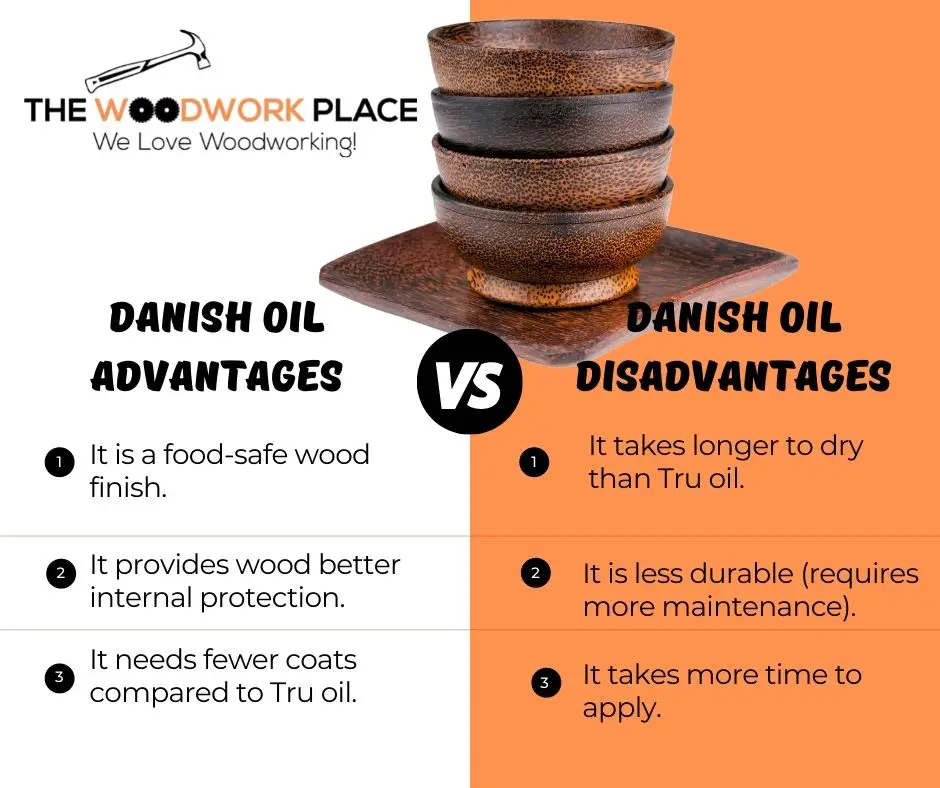You’re probably already familiar with oil finishes. Typically used to enhance the look of wood, (and protect woodwork from moisture), these high quality oil blends are help to preserve wood from the inside out.
Danish oil, (a finish made from a blend of linseed oil and varnish), is one such finish. Cost-effective and simple to use, once applied Danish oil dries in roughly 4-6 hours. And once cured, it leaves behind a satin like finish that’s easy to upkeep.
But what if time is of the essence, and you want an oil finish that gives you a satin finish… but in just half the time.
Here is where Tru oil can really shine. Tru oil as a wood finish can dry in as little as 2 hours. Its tougher and more durable than Danish oil, and it doesn’t yellow with age.
But, does Tru oil really hold up as an alternative to Danish oil? Well, keep reading to learn more about the in’s and out’s of these two popular wood finishes…

This post may contain affiliate links to products that we receive a commission for (at no additional cost to you). Learn more here.
What You Need To Know About Tru Oil
Key Features
- Drying Time: 2-4 hours
- Curing Time: 7-14 Days
- What Is Tru Oil Made Of? Linseed and/or Tung Oil, Varnish, and Mineral Paint Thinners
So, First Off, Is Tru Oil Natural?
Tru-oil contains a blend of natural oils and other additives.
But, it is a flammable liquid, and not a 100% pure oil.
Related Post: Tru-oil vs Linseed Oil: The Top 5 Things You All Wanted To Know
Is Tru Oil A Good Finish?
Yes, it absolutely is. It is incredibly easy to apply. And its ability to leave behind a glossy finish makes it a great choice for finishing Guitars and Banjos.
That glossy finish is due to the fact that Tru oil tends to ‘build’ up a bit of a film finish on the surface of wood (in a way that Danish oil doesn’t).
Don’t get me wrong, it’ll still soak into wood like Danish oil does too. However, it penetrates the wood less deeply than Danish oil – but only slightly less.
On top of that, the mineral paint thinner added to Tru oil makes this finish thin enough to easily wipe on with a rag – without requiring a brush to get it coat timber evenly.
Does Tru Oil Protect Wood?
Yes, Tru oil does protect wood very well. Due to Tru oils ability to build up a film on the surface of wood, it offers a higher level of protection than Danish oil can.
Top 3 Pros of Tru Oil
- It dries faster than Danish oil (in under 4 hours).
- It is more durable than Danish oil finishes.
- And it is easier to apply than Danish oil too.
Top 3 Cons of Tru Oil
- Tru oil doesn’t penetrate wood as deeply as Danish oil.
- Tru oil requires a lot more coats than Danish oil for an even finish (around 12-15 coats).
- It’s glossier finish makes wood look less ‘natural’ compared to a Danish oil finish.

What You Need To Know About Danish Oil
Key Features
- Drying Time: 4-8 hours
- Curing Time: 72 hours (but it can take up to 30 days in cold or humid environments)
- What Is Danish Oil Made Of? Linseed and/or Tung Oil, Varnish, and Mineral Spirits
What Is Danish Oil Good For?
It’s good on any kind of interior low-use woodwork.
So things like cabinets and wood panelling do great with a coat of Danish. However high-usage items, like tables and chairs, need something that’s more durable than what Danish oil can offer.
Plus, this oil finish is also food safe and non-toxic, (once it has properly dried and cured). So it can be used to finish off wooden utensils such as butcher blocks, bowls and wooden spoons.
Related Post: 5 Easy Halloween Wooden Spoons (Make ‘Em In Under 30 Minutes!)
And Is Danish Oil Waterproof Too?
Waterproof? No.
But, is it water/moisture resistant? Yes.
And what’s the difference between those two definitions? Well, water-resistant means that Danish oil makes it difficult for water droplets to get into wood.
But waterproof would mean that Danish oil could act as a complete barrier preventing all and any water from getting through.
Danish oil just isn’t that kind of finish. If you want a finish that offers real waterproofing then you need a sealant, such as Polyurethane or Lacquer.
Related Post: What Is The Difference Between Lacquer and Polyurethane?
If It Is Not Waterproof, How Protective Is Danish Oil?
Well, Danish oil offers protection against heat damage, and minor scratches and dents.
Which is why it is better used on low-use wood pieces that aren’t going to go through a lot of handling.
Does Danish Oil Turn Yellow With Time?
If it is exposed to a lot of sunlight, then the UV rays in the sun can cause Danish oil to turn a little bit yellow.
The yellowing isn’t as severe as you might get with say an aging pure Linseed oil finish. But it is noticable.
Related Post: How To Make Linseed Oil Dry Faster (What You Need To Know)
Top 3 Pros of Danish Oil
- It is a food-safe wood finish.
- It really soaks into wood – providing better internal protection.
- It needs fewer coats compared to Tru oil. Just 4 to 5 coats of this stuff is more than enough.
Top 3 Cons of Danish Oil
- It takes longer to dry than Tru oil.
- It is less durable than Tru oil (and requires more maintenance).
- It takes more time to apply.

So, To Quickly Sum Up
If you want a glossy looking finish, then opt for Tru oils quick and easy product.
But if you want a more natural looking wooden surface, then take the extra time to apply Danish oil instead.


